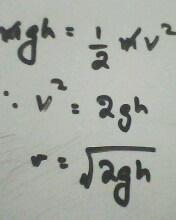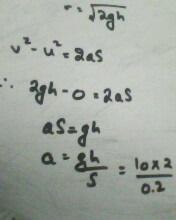ans 5 .
since the mass is in equilibrium .
Let ∂ be the angle of inclination
mg Sin ∂ ≤ mg Cos ∂ μ
thus tan ∂ ≤ μ
∂ ≤ tan-1(μ)
Q1)A heavy iron bar of weight W is having its one end on the ground and other on the shoulder of a man.The rod makes an angle θ with the horizontal.What is the weight experienced by the man?
a)W sinθ b) W cosθ
c)W d)W/2
Q2)A ball of mass 0.2 Kg is thrown vertically upward by applying a force by hand.If the hand moves 0.2 m while applying the force and the ball goes upto 2 m height further,find the magnitude of the force.(g=10m/s2)
a)16 N b)20 N
c)22 N d)4 N
Q3)25 N force is required to raise 75 Kg mass from a pulley.If rope is pulled 12 m,then the load is lifted to 3 m,the efficiency of pulley system will be
a)25% b)33.3%
c)75% d)90%
Q4)A given object takes n times more time to slide down 45° rough inclined plane as it takes to slide a perfectly smooth 45° incline.The coffecient of kinetic friction between the object and the incline is
a)1/2-n2 b)1-(1/n2)
c)√1-(1/n2) d)√1/1-n2
Q5)A mass placed on an incline plane is just in equilibrium.If μ is cofficient of friction of the surface,then maximum inclination of the plane with the horizontal is
a)tan-1μ b)tan-1(μ/2)
c)sin-1μ d)cos-1μ
ans 5 .
since the mass is in equilibrium .
Let ∂ be the angle of inclination
mg Sin ∂ ≤ mg Cos ∂ μ
thus tan ∂ ≤ μ
∂ ≤ tan-1(μ)
Ans 4
Let the angle of inclination be θ .
For Smooth surface
mg Sinθ = ma
=> a = g Sin 45 0 = g/√2
Let s m be the length of incline
s= gt2/2√2 -----(1)
For rough incline
coeficient of kinetic friction = μ
acceleration be a m/s2
mgSin 450 - mg Cos 450 μ = ma
a = g(1 - μ)/√2
time taken = nt
now s =g(1 - μ) n2t2/2√2 ---------(2)
equating 1 and 2
gt2/2√2 = g(1 - μ) n2t2/2√2
=> 1 = ( 1- μ) n2
simplifying
μ = 1- (1/n2)
for 1st, not quite sure, since had it been the ans, it had been quite simple as resolution of vectors, and there wud have been no doubt...
for 2nd, maybe what i did is lenthier, there cud be ny short method/s too, but hope u get this...
we have to move step by step here...first equate P.E. at the max height with potential energy at time of release...
now, this gives us the velocity of the body wen it was released...
now, by 3rd eqn of motion, v2-u2=2aS
here, we get the acceleration, and the work after this is easy...F=ma
Q1)A heavy iron bar of weight W is having its one end on the ground and other on the shoulder of a man.The rod makes an angle θ with the horizontal.What is the weight experienced by the man?
a)W sinθ b) W cosθ
c)W d)W/2
This is a good question
draw the fbd
N1+N2=W
N2xL=WxL/2
so N2=W/2
so u mean bhaiyya for any angle θ d weight experienced is only half of d weaight????
akand........that simple application of torque............
physics never lies................
try it for different angles of @[3]